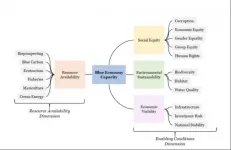(Press-News.org) DALLAS - March 17, 2021 - UT Southwestern researchers have identified the structure of a key member of a family of proteins called nicotinic acetylcholine receptors in three different shapes. The work, published online today in Cell, could eventually lead to new pharmaceutical treatments for a large range of diseases or infections including schizophrenia, lung cancer, and even COVID-19.
Nicotinic acetylcholine receptors are members of a broader super-family of proteins called Cys-loop receptors that function as ion channels on cell surfaces and are found in the membranes of many cell types. When the right molecule settles on these receptors, it opens the gated channels, letting ions flood from the outside to the inside of cells to trigger other cellular processes. Nicotinic acetylcholine receptors respond to acetylcholine, a molecule that nerve cells use to communicate with each other. However, they also respond to other molecules found outside the body, such as nicotine, the essential nutrient choline, and a toxin found on the skin of poison dart frogs called epibatidine.
These receptors, which have been identified in nerve, lung, and immune cells, are connected to conditions such as mental illness, neurodegenerative diseases, lung cancers, and even the destructive immune reactions characteristic of COVID-19 and other infections.
Researchers had previously identified the structures of some members of the Cys-loop super-family, a significant step toward creating drugs that fit onto these ion channels to block or enhance their function. However, say study leaders Colleen M. Noviello, Ph.D., Senior Research Scientist at UTSW, and Ryan E. Hibbs, Ph.D., Associate Professor of Neuroscience and Biophysics at UTSW, the shape, or conformation, of these channels isn't fixed. Cys-loop receptors cycle through three major states during their gating cycle that correspond to when they're closed and waiting to respond to a ligand, or activating molecule (resting state); when they've responded to the ligand and opened for ion flow (open state); or when they are still holding the ligand but have closed again (desensitized state).
After striking out for years to characterize the structure of a key nicotinic acetylcholine receptor called a7, Noviello and Hibbs got a major boost in 2016 after UTSW purchased equipment for cryogenic electron microscopy, or cryo-EM. This technology allows scientists to take photos of biologic molecules at atomic level resolution. When the researchers and their colleagues added to a7 a chaperone protein - a protein that helps support and protect other proteins - it helped a7 retain its proper shape.
With these new tools, the researchers imaged a7 in its different conformations. Because a7's structure is dynamic, allowing it to shift and wiggle, the researchers added different ligands to stabilize it so the cryo-EM images wouldn't be blurry from motion.
When they analyzed these images, Noviello, Hibbs, and their colleagues found several interesting structural features that helped explain some of a7's unusual properties. For example, a negatively charged amino acid in a7's inner channel seems to draw in positively charged calcium from outside cells, explaining why a7 is so permeable to calcium. Also, a curved structure on a7 seems to function as a latch to open the gated channel.
The team says that these newly identified structures for a7 could eventually be used as a template for pharmaceutical companies to develop new medicines that target this and related nicotinic acetylcholine receptors. They plan to continue studying a7 in various cell types and how it interacts with other molecules and proteins.
"The more we know about this important receptor found on so many diverse cell types, the closer we'll get to understanding how it functions in physiology and disease," says Hibbs, an Effie Marie Cain Scholar in Medical Research and member of the Peter O'Donnell Jr. Brain Institute.
INFORMATION:
Other researchers who contributed to this study include Anant Gharpure, Rico Cabuco, Leah Baxter, and Dominika Borek, all of UTSW; and Nuriya Mukhtasimova and Steven M. Sine, of Mayo Clinic College of Medicine.
This research was funded by National Institutes of Health grants (U24GM129547, NS120496, NS077983, NS095899, NS94124), and by the Friends of the Alzheimer's Disease Center.
About UT Southwestern Medical Center
UT Southwestern, one of the premier academic medical centers in the nation, integrates pioneering biomedical research with exceptional clinical care and education. The institution's faculty has received six Nobel Prizes, and includes 23 members of the National Academy of Sciences, 17 members of the National Academy of Medicine, and 13 Howard Hughes Medical Institute Investigators. The full-time faculty of more than 2,500 is responsible for groundbreaking medical advances and is committed to translating science-driven research quickly to new clinical treatments. UT Southwestern physicians provide care in about 80 specialties to more than 105,000 hospitalized patients, nearly 370,000 emergency room cases, and oversee approximately 3 million outpatient visits a year.
From climate change and carbon emissions to biodiversity and global hunger, humanity faces so many challenges that tackling them quickly is a daunting task. One solution that potentially addresses multiple issues could provide the impetus society needs to make significant progress.
An international team of 26 authors, including six at UC Santa Barbara, has just published a study in the prestigious journal Nature offering a combined solution to several of humanity's most pressing challenges. It is the most comprehensive assessment to date of where strict ocean protection can contribute ...
BOSTON - There are several effective interventions to reduce the risk of suicide, the tenth-leading cause of death in the United States, but difficulties in identifying people at risk for suicide and concerns about the potentially high costs of suicide-prevention strategies have hampered their wider use.
But as researchers at Massachusetts General Hospital (MGH) demonstrate, statistical suicide risk prevention models could be implemented cost-effectively in U.S. health care systems and might help save many lives each year.
By evaluating data on the incidence of suicide and suicide attempts, the costs to society and the health care system of suicide, and the cost and effectiveness of suicide risk-reduction interventions, Eric ...
Increased global temperatures help invasive species establish themselves in ecosystems, new research led by a Swansea University bioscientist has shown.
The study, published by the Royal Society, gives an insight into the probable combined effects of species invasions, which are becoming more common, and global warming.
Climate warming and biological invasions result in the loss of species. They also alter the structure of ecosystems and the ways in which species interact.
While there is already extensive research on how climate change and invasions affect ...
London, UK (17 March 2021)--A new study published in the prestigious peer-reviewed scientific journal Nature today offers a combined solution to several of humanity's most pressing challenges. It is the most comprehensive assessment to date of where strict ocean protection can contribute to a more abundant supply of healthy seafood and provide a cheap, natural solution to address climate change--in addition to protecting embattled species and habitats.
An international team of 26 authors identified specific areas that, if protected, would safeguard over 80% of the habitats for endangered marine species, and increase fishing catches by more than eight million metric tons. The study is also the first to quantify the potential release of carbon dioxide into the ocean ...
One of the best ways to study human evolution is by comparing us with nonhuman species that, evolutionarily speaking, are closely related to us. That closeness can help scientists narrow down precisely what makes us human, but that scope is so narrow it can also be extremely hard to define. To address this complication, researchers from Stanford University have developed a new technique for comparing genetic differences.
Through two separate sets of experiments with this technique, the researchers discovered new genetic differences between humans and chimpanzees. They found a significant ...
Stopping the spread of political misinformation on social media may seem like an impossible task. But a new study co-authored by MIT scholars finds that most people who share false news stories online do so unintentionally, and that their sharing habits can be modified through reminders about accuracy.
When such reminders are displayed, it can increase the gap between the percentage of true news stories and false news stories that people share online, as shown in online experiments that the researchers developed.
"Getting people to think about accuracy makes them more discerning in their sharing, regardless of ideology," says MIT professor David Rand, co-author of a newly published paper detailing the results. "And it translates ...
Among adults with children living in the home, cannabis use was more common in states with legalized cannabis use, according to a new study by Columbia University Mailman School of Public Health, Columbia Irving Medical Center and the City University of New York. Legalization for recreational and medical use were both linked with significantly higher prevalence of past-month and daily cannabis use. Until now, most tobacco control and harm reduction efforts protecting youth from exposure to secondhand tobacco smoke focused on parental cigarette smoking, ensuring smoke-free homes, and not smoking in the presence of children. The findings are published ...
The future of an equitable and sustainable global ocean, or "Blue Economy," depends on more than the resources available for technological advancement and industry expansion. A recent UBC-led study found that socioeconomic and governance conditions such as national stability, corruption and human rights greatly affect the ability to achieve a Blue Economy.
The study, published today in Nature, scored criteria across five global regions: Africa, Americas, Asia, Europe and Oceania, to identify the areas of investment and research necessary to develop ocean resources in a manner that is consistent with a Blue Economy ethos (socially ...
To observe how a tiny ball of identical cells on its way to becoming a mammalian embryo first attaches to an awaiting uterine wall and then develops into nervous system, heart, stomach and limbs: This has been a highly-sought grail in the field of embryonic development for nearly 100 years. Prof. Jacob Hanna of the Weizmann Institute of Science and his group have now accomplished this feat. The method they created for growing mouse embryos outside the womb during the initial stages after embryo implantation will give researchers an unprecedented tool for understanding the development program encoded in the genes, and it may provide detailed insight into birth and developmental defects as well as those involved ...
Forces acting inside the Earth have been constantly reshaping the continents and ocean basins over millions of years. What Alfred Wegener published as an idea in 1915 has finally been accepted since the 1960s, providing a unifying view about our planet. The fact that the theory of plate tectonics took so long to gain acceptance had two simple reasons. First, the geological formations that are most important for its understanding lie at the bottom of the oceans. Secondly, forces controlling the processes act below the seafloor and are hence hidden from our view. Many details of plate tectonics are therefore still unclear today.
Today, ...

